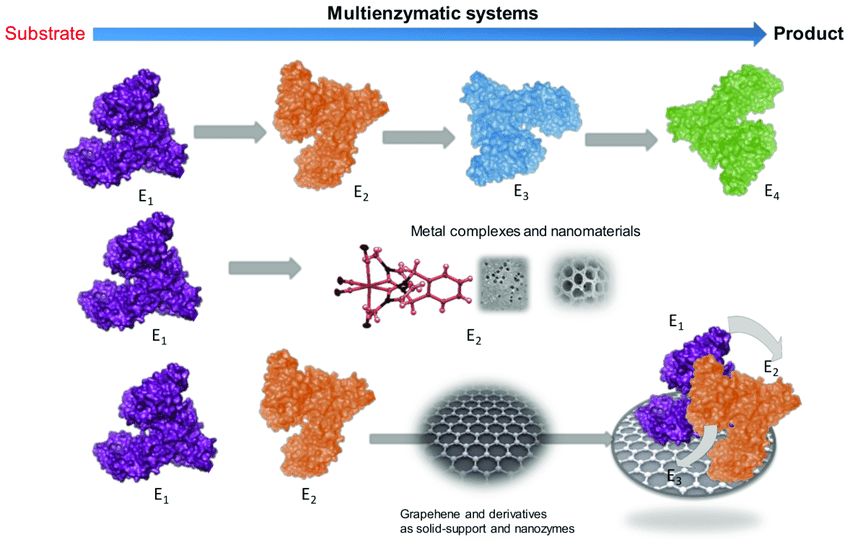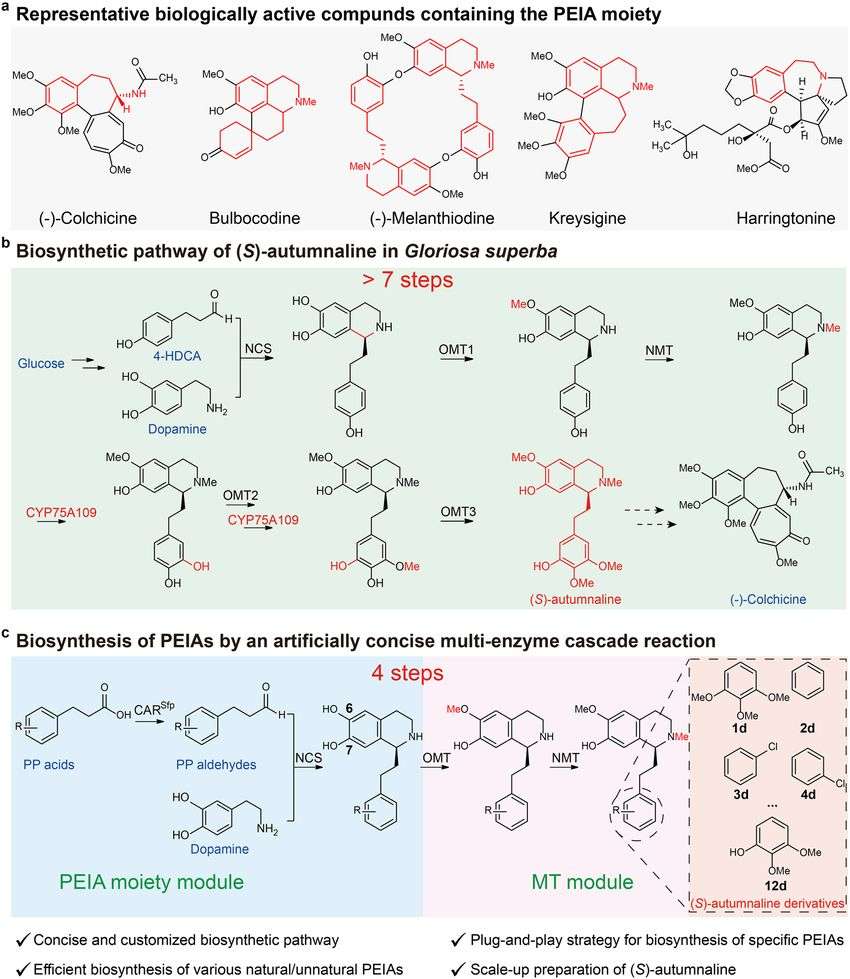Enzyme cascade design is a cutting-edge scientific process that involves the strategic arrangement of multiple enzymes to perform complex reactions in a stepwise manner. This methodology is critical in studying and comprehending biological systems, as it closely mirrors the natural metabolic pathways present within cells. By ingeniously designing these enzyme cascades, we can optimize and streamline biological reactions, boost efficiency, and pave the way for new metabolic pathways that can lead to the production of valuable and commercially significant compounds.
 Different concepts of multi-enzymatic cascade processes(Noelia Losada-Garcia, et al., 2020)
Different concepts of multi-enzymatic cascade processes(Noelia Losada-Garcia, et al., 2020)
Service Process
Our approach to enzyme cascade design involves a detailed, five-step process for thorough planning and execution:
- Define the Target Reaction: The first step involves defining the target reaction. This requires understanding the specific biochemical transformation we aim to achieve and identifying suitable enzymes to facilitate this reaction efficiently. We conduct a comprehensive analysis of potential enzymes, considering their catalytic capabilities and specificities.
- Design the Enzyme Cascade: After identifying the enzymes, we design the enzyme cascade. This step requires careful consideration of various factors, such as enzyme compatibility, reaction kinetics, and ideal reaction conditions like pH, temperature, and substrate concentration. A well-designed cascade ensures minimal side reactions and maximal yield.
- Test the Designed Cascade: We then test the designed cascade in a controlled environment to evaluate its effectiveness, efficiency, and robustness. This step helps us identify potential bottlenecks, inefficiencies, and areas for improvement.
- Optimize the Cascade Design: Based on the test results, we optimize the cascade design. This may involve refining enzyme concentrations, reaction conditions, or even rearranging the order of reactions to maximize efficiency, output, and cost-effectiveness.
- Scale Up for Industrial Application: Once the design is optimized and tested satisfactorily, we scale up the enzyme cascade for industrial application. This final step involves adapting the process for large-scale production while ensuring that the cascade maintains its efficiency and effectiveness, thereby facilitating large-scale production of the desired product.
We're here to assist you. If you have any questions, need more information, or would like to discuss a potential project, please don't hesitate to contact us. Our team is always eager to help and share our expertise.
Applications
| Application |
Description |
| Biomedical Research |
Enzyme cascade design finds extensive application in biomedical research, particularly in studying signal transduction pathways, biochemical reactions, and cellular processes. It helps in understanding the intricate mechanisms of diseases such as cancer, neurodegenerative disorders, and metabolic syndromes. Researchers use enzyme cascades to mimic biological processes, aiding in drug development, target identification, and validation. |
| Biocatalysis |
Enzyme cascades are employed in biocatalysis for the synthesis of valuable compounds, pharmaceutical intermediates, and fine chemicals. They enable efficient conversion of substrates into desired products, offering high specificity and selectivity. Enzyme cascades are crucial in green chemistry initiatives, contributing to sustainable manufacturing processes and reducing environmental impact. |
| Biosensors |
Enzyme cascades play a pivotal role in biosensor technology for detecting various analytes with high sensitivity and specificity. They are utilized in medical diagnostics, environmental monitoring, and food safety assessment. By incorporating multiple enzymes, biosensors can detect complex biomolecular interactions, enabling rapid and accurate detection. |
| Synthetic Biology |
Enzyme cascades are fundamental in synthetic biology for constructing synthetic metabolic pathways and cellular circuits. They facilitate the production of biofuels, pharmaceuticals, and industrial chemicals in engineered microorganisms. Enzyme cascades enable the design of complex genetic circuits for programming cellular behavior and creating novel biological functions. |
| Nanotechnology |
Enzyme cascade-based nanodevices find applications in nanomedicine, nanosensors, and targeted drug delivery systems. They offer precise control over biochemical reactions at the nanoscale, enhancing therapeutic efficacy and reducing side effects. Enzyme cascades are integrated into nanomaterials for designing smart drug delivery platforms capable of responding to specific stimuli. |
| Environmental Remediation |
Enzyme cascades are utilized in environmental biotechnology for remediation of pollutants, wastewater treatment, and bioremediation of contaminated sites. They degrade toxic compounds into harmless byproducts, contributing to the cleanup of oil spills, industrial effluents, and hazardous waste. Enzyme cascades are engineered into microbial consortia for enhanced degradation of complex pollutants, offering sustainable solutions for environmental challenges. |
Case Study
The figure below illustrates the design of an artificially concise multi-enzyme cascade for the biosynthesis of PEIAs. (a) Representative biologically active compounds containing the PEIA moiety. The PEIA moiety is highlighted in red. (b) Natural biosynthetic pathway of (S)-autumnaline in G. superba with more than 7 steps. (c) Construction of an artificial multi-enzyme cascade with the PEIA moiety module and the MT module for the biosynthesis of (S)-autumnaline and its derivatives. The advantages of this cascade are indicated. CAR carboxylic acid reductase, Sfp phosphopantetheine transferase, NCS norcoclaurine synthase, OMT O-methyl transferase, NMT N-methyl transferase, PP acids phenylpropionic acids, PP aldehydes phenylpropionic aldehydes.
 Modular assembly of an artificially concise biocatalytic cascade for the manufacture of phenethylisoquinoline alkaloids(Yue Gao, et al., 2024)
Modular assembly of an artificially concise biocatalytic cascade for the manufacture of phenethylisoquinoline alkaloids(Yue Gao, et al., 2024)
FAQs
Here are some common questions along with their responses which provide a comprehensive understanding of the concept, advantages, challenges, and applications of enzyme cascade design.If you have more specific or detailed questions, don't hesitate to get in touch with us directly.
Q: What is the primary objective of enzyme cascade design?
A: The primary objective of enzyme cascade design is to emulate and augment natural metabolic pathways. This approach not only enhances efficiency, but it also broadens the possibilities for the production of valuable compounds. This can have a transformative impact on a variety of industries, including pharmaceuticals, biotechnology, and food and beverage, to name a few. By creating more efficient and versatile biochemical reactions, enzyme cascade design can catalyze the development of new products and technologies.
Q: How does the process of enzyme cascade design work?
A: Enzyme cascade design is an intricate process that involves the strategic arrangement of multiple enzymes to carry out complex biochemical reactions in a sequential manner. This process closely mirrors the functioning of natural metabolic pathways within cells. Each enzyme in the cascade is carefully selected and positioned to maximize the efficiency and productivity of the reaction. Additionally, factors such as enzyme compatibility and optimal reaction conditions are taken into account during the design process.
Q: Can enzyme cascade design be applied in the industry?
A: Yes, enzyme cascade design has wide-ranging applications across various industries. It is extensively used in the biotechnology and pharmaceutical sectors to manufacture a plethora of products. In the biotechnology industry, for example, enzyme cascade design can facilitate the production of biofuels and bioplastics in a more sustainable and efficient manner. In the pharmaceutical industry, it can enable the production of complex drugs that require intricate biochemical reactions.
Q: What are the benefits of enzyme cascade design?
A: Enzyme cascade design offers several benefits. Firstly, it can significantly enhance the efficiency and yield of biochemical reactions. Secondly, by imitating natural metabolic pathways, it can facilitate the production of a wide array of valuable compounds. Furthermore, it can enable the development of new metabolic pathways that were previously unachievable, opening up new possibilities for the production of novel compounds.
Q: What are the challenges in enzyme cascade design?
A: While enzyme cascade design offers numerous benefits, it also comes with its own set of challenges. These include the need for a comprehensive understanding of the enzymes involved, their interactions, and the conditions required for optimal performance. Additionally, scaling up the process for industrial applications can be complex and requires careful planning and optimization.
Q: How can enzyme cascade design contribute to sustainable development?
A: Enzyme cascade design can play a significant role in promoting sustainable development. By facilitating more efficient and sustainable production processes, it can help reduce the environmental impact of various industries. For example, in the biotechnology sector, it can enable the production of biofuels and bioplastics, offering a more environmentally friendly alternative to traditional fossil fuels and plastics.
Q: What is the future outlook for enzyme cascade design?
A: The future of enzyme cascade design looks promising, with potential applications across a wide range of sectors. As our understanding of enzymes and their interactions continues to grow, so too will the possibilities for enzyme cascade design. This could lead to the development of new products and technologies, revolutionizing various industries and contributing to sustainable development.
Q: What is the role of technology in enzyme cascade design?
A: Technology plays a pivotal role in enzyme cascade design. Advanced computational tools and techniques can aid in the selection and positioning of enzymes in the cascade, optimizing the efficiency and productivity of the reaction. Additionally, technology can facilitate the scaling up of the process for industrial applications, enabling the large-scale production of valuable compounds.
Q: How does your organization contribute to the field of enzyme cascade design?
A: Our organization is at the forefront of enzyme cascade design. We employ a comprehensive, five-step process to design enzyme cascades, which includes defining the target reaction, designing the enzyme cascade, testing the designed cascade, optimizing the cascade design, and scaling up for industrial application. Our expertise and commitment to innovation have enabled us to make significant contributions to the field and to support our clients across various sectors.

































 Different concepts of multi-enzymatic cascade processes(Noelia Losada-Garcia, et al., 2020)
Different concepts of multi-enzymatic cascade processes(Noelia Losada-Garcia, et al., 2020)
 Modular assembly of an artificially concise biocatalytic cascade for the manufacture of phenethylisoquinoline alkaloids(Yue Gao, et al., 2024)
Modular assembly of an artificially concise biocatalytic cascade for the manufacture of phenethylisoquinoline alkaloids(Yue Gao, et al., 2024)